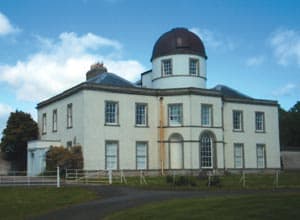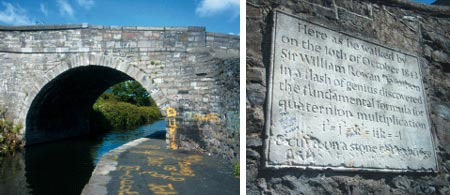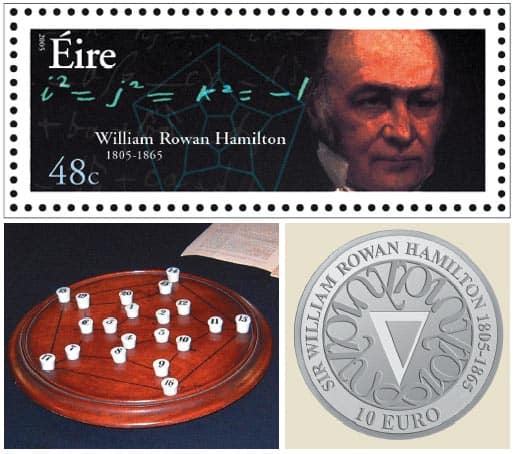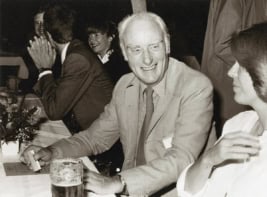This year Ireland celebrates the bicentenary of the mathematician William Rowan Hamilton, best remembered for "quaternions" and for his pioneering work on optics and dynamics
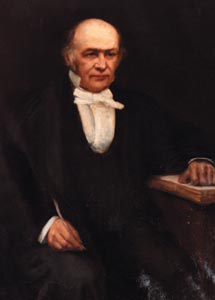
William Rowan Hamilton was born in Dublin at midnight between the 3rd and 4th of August 1805. His father, Archibald Hamilton, was a solicitor, and his mother, Sarah (née Hutton), came from a well-known family of coachbuilders in Dublin. Before his third birthday, William was sent to live with his uncle, James Hamilton, who was a clergyman of the Church of Ireland and curate of Trim, County Meath. Being in charge of the diocesan school there, James was responsible for his young nephew’s education.
William showed an astonishing aptitude for languages, and by the age of five was already making good progress in Latin, Greek and Hebrew. Before he turned 12, he had broadened his studies to include French, Italian, Arabic, Syriac, Persian and Sanskrit. Of particular interest to him were Semitic languages such as Hebrew, Syriac and Arabic because of the many early biblical texts written in those languages. Religion was always important in the lives of Hamilton and his family, although William himself never had any desire to take holy orders.
As a boy, Hamilton also spent some time studying Indian languages because his family thought that there might be a career opening for him with the East India Company. But as he grew older, his uncle ensured that Hamilton concentrated his attention on the classical languages, Latin and Greek, which formed a major portion of the curriculum at Trinity College, Dublin.
While Hamilton was being prepared for entry to Trinity College, where he was expected to excel, fellows and professors of the college were setting out to modernize the teaching of mathematics there by introducing French textbooks into the curriculum, translating some of these into English, and writing their own material. When Hamilton was 16, his uncle – obviously realizing that William would need to excel in both mathematics and classics at college – gave him a copy of a textbook written by Bartholomew Lloyd, professor of mathematics at Trinity.
This book awakened Hamilton’s interest in mathematics, and he immediately set about studying contemporary French textbooks and monographs on the subject, including major works by Lagrange and Laplace. Indeed, he found an error in one of Laplace’s proofs, which he rectified with a proof of his own. He also began to undertake his own mathematical research. The fruits of his investigations were brought to the attention of John Brinkley, then Royal Astronomer of Ireland, who encouraged Hamilton in his studies and gave him a standing invitation to breakfast at the Observatory of Trinity College, at Dunsink, whenever he chose.
Optical investigations
Hamilton achieved first place in the entrance examination for Trinity College and began his studies there in 1823. His academic progress as an undergraduate was exceptional. No other student beat him in any examination. He received an “optime” (a distinction that was very rarely awarded) in Greek in his first year. Two years later, he received another optime, this time in mathematical physics. Nevertheless, he found the intensive study required to achieve such distinctions increasingly irksome because it gave him less time to pursue his growing interests in science and mathematics.
At the time, Hamilton was carrying out an intensive study of Newton’s Principia, and was undertaking highly original and sophisticated mathematical investigations in optics. He was employing to the full the methods of calculus and of differential geometry that had been developed in France over the previous 50 years. Hamilton initially thought that he was the first mathematician to apply such methods to the study of optical problems. But one day his college tutor took Hamilton into the college library and showed him a paper on optics by the French mathematician Etienne-Louis Malus. Dating from 1807, it turned out that Malus had already discovered these results.
In 1824, aged just 19, Hamilton submitted a paper on optics to the Royal Irish Academy, for publication in its Transactions. Although the paper was not accepted as it stood, Hamilton was encouraged to develop and expand on his ideas and methods. This he did, submitting a substantial paper to the academy entitled “Theory of systems of rays”. The first part of this paper was published in 1828, the year after Hamilton graduated.
Hamilton’s obvious mathematical ability encouraged the college to appoint him to the post of Andrews’ Professor of Astronomy in 1827, which carried with it the title of Royal Astronomer of Ireland. Hamilton’s home thereafter was at the observatory at Dunsink, which lies about five miles from the centre of Dublin. Unsuccessful candidates for the post included George Biddell Airy, later to be appointed Astronomer Royal, and a number of experienced fellows of the college. Unfortunately, no astronomical work of any particular significance was undertaken at the observatory in Hamilton’s time due to antiquated instruments and an inappropriate observing programme – devised decades earlier – that the Royal Astronomer was legally required to carry out.
Instead, Hamilton focused his talents on his mathematical investigations. In his 1828 paper he had made a detailed study of the foci and images that are produced by the reflection of light off curved mirrors. He studied the aberrations in images produced by reflection, and – using analytical methods that he had learnt from his study of Laplace – conducted a thorough investigation into the relative intensity of light along the “caustic” surfaces of brightness that are created when light reflects off a curved mirror.
Hamilton published three supplements to his original paper. In the first two, he applied his methods to treat the refraction of light at the boundaries between isotropic media. In his celebrated “third supplement”, these methods were generalized for anisotropic media, in which the speed of light depends on the direction in which it is travelling in the medium. In particular, he showed that any optical system could be described by a certain “characteristic function”. In the wave theory of light, this function measures the time that light takes to travel from one point to another and depends on the co-ordinates of those two points. Hamilton showed that if the form of this characteristic function was known, all significant optical properties of the system could be expressed in terms of the function and its partial derivatives.
Conical refraction
When Hamilton presented his third supplement to the Royal Irish Academy in October 1832, he made a surprising prediction concerning the way in which certain crystals affect the path of light. Most physical scientists in the early 19th century favoured Isaac Newton’s theory of light as streams of “corpuscles” travelling in accordance with dynamical laws. They did not accept the rival wave theory of light, which had originally been advocated by a number of scientists in the 17th century, notably Christiaan Huygens. He had used the wave theory to explain why a ray of unpolarized light entering or leaving a “uniaxial” crystal, for example an Iceland spar, is refracted as two rays, each of which is linearly polarized.
The wave theory was largely neglected throughout the 18th century because it did not appear to explain phenomena such as polarization. The problem was that it supposed that light waves – like sound waves – are purely longitudinal. However, support for the theory was revived at the start of the 19th century by Thomas Young, who realized that polarization phenomena could be best explained if light has both a transverse and a longitudinal component. This inspired a young French scientist and engineer, Augustin Fresnel, to develop an extensive theory of light propagation in terms of purely transverse vibrations of tiny ether particles within each wavefront.
This theory was found to explain the properties of not only uniaxial crystals but also “biaxial” crystals, such as aragonite, the optical properties of which had been discovered by David Brewster a few years earlier. These crystals have two “optic axes”, whereas uniaxial crystals have only one. (Light travelling down an optic axis may be linearly polarized with the magnetic field pointing in any direction perpendicular to the ray; for light travelling in any other direction, the magnetic field can only point in one of two determined directions, which are at right angles to each other and to the ray.)
In the autumn of 1832 Hamilton undertook a mathematical analysis of the wave surface that describes the propagation of light in a biaxial crystal according to Fresnel’s theory. This surface represents the position of the light that has propagated out from a point source within the crystal in a fixed period of time. On the basis of the elegant and general theory of light that he had developed in his third supplement, Hamilton predicted that the geometrical properties of the surface should have two surprising physical consequences. First, unpolarized light incident on a biaxial crystal at certain angles would be refracted to form a hollow cone of rays; this light would then emerge from the crystal in the form of a hollow cylinder. Second, rays of light travelling in certain directions within the crystal would be refracted on emergence to form a hollow cone of rays. The two phenomena are known as “internal” and “external” conical refraction, respectively.
Hamilton asked his colleague Humphrey Lloyd, then professor of natural philosophy at Trinity, to verify this prediction experimentally. Lloyd initially had some difficulty in obtaining a crystal of sufficient size and purity, but within two months he had shown that conical refraction was a real effect. This work aroused considerable interest within the scientific community because it was the first time that a physical phenomenon had been predicted through mathematical analysis and then subsequently verified by experiment. A 20th-century analogue would be the discovery of the positron, which had been predicted by Paul Dirac based on his relativistic wave equation for the electron. The discovery of conical refraction did much to lend support to the wave theory of light, since the prediction was made on the basis of Fresnel’s theory.
Dynamics and quaternions
In 1834 and 1835 Hamilton published two major papers on dynamics in the Philosophical Transactions of the Royal Society. The first took methods that he had developed in his optical research and adapted them to the study of dynamical systems, utilizing a characteristic function analogous to the one he had introduced for the study of optical systems. The second paper presented his methods in a much more elegant and refined form and initiated a revolution in the mathematical study of dynamics.
Hamilton examined the evolution of a “conservative” dynamical system – one, like the solar system, that satisfies the conservation of energy – and found that it is determined by an associated “principal function”. This function depends on the time taken for the system to evolve from one configuration to another, and on variables, such as lengths and angles, that determine the initial and final configurations. If the precise form of this principal function is known, then one can write down equations that determine the evolution of the system without having to solve any differential equations.
In this paper, Hamilton also presented the equations of motion of a conservative dynamical system in an extremely elegant form. As mathematics has developed, it has been found that many systems of differential equations may be presented in this same “Hamiltonian” form and studied using methods developed by Hamilton and his successors.
Hamilton’s other great interest was in the close relationship between the algebra of complex numbers and geometry, which was explored by Jean-Robert Argand and a number of other mathematicians at the beginning of the 19th century. As all physicists know, a complex number of the form z = x + yi, where i = √-1, can be represented by the point (x, y) on a Cartesian plane. Conversely, any point on the plane can be represented by a complex number, while any combination of successive translations, rotations and enlargements of the plane may be represented by a function that sends any complex number z to (az + b), where a and b are complex numbers that are constants independent of z.
Inspired by the link between complex numbers and plane geometry, Hamilton and others tried to seek an algebra of complex numbers that bears the same relationship with 3D geometry. It seemed natural to suppose that the elements of such an algebra would be represented by triplets of the form (x, y, z). For over 13 years Hamilton attempted to construct a satisfactory triplet algebra related to 3D geometry. His search ended in an unexpected fashion on 16 October 1843, while walking with his wife Helen along the towpath of the Royal Canal, near Dublin on his way to attend a meeting of the council of the Royal Irish Academy.
In a flash, Hamilton realized that the appropriate algebra was not a triplet algebra but a 4D algebra of what he called “quaternions”. He immediately jotted down in a pocket-book the basic formulae for multiplying quaternions, and later claimed that, in the excitement of discovery, he had also carved these basic formulae on one of the bridges over the canal. A stone plaque commemorating the location can still be seen today.
A quaternion is a 4D complex number that is of the form q = w + xi + yj + zk, where i, j and k are all different square roots of -1. The quaternion can be regarded as an object composed of a scalar part, w, which is a real number, and a vector part, xi + yj + zk. Moreover, the vector part may be represented, in magnitude and direction, by a line joining two points in 3D space. Many mathematical terms in common use today – including scalar and vector – were introduced by Hamilton, as he developed the theory of quaternions.
Legacy of a genius
Most of Hamilton’s subsequent research was devoted to developing the theory of quaternions. He wrote many papers and two long books on the subject, investigating the algebraic properties of quaternions and related systems, and applying quaternions to various problems in geometry and physics. Interestingly, Peter Guthrie Tait and James Clerk Maxwell applied the theory to problems involving heat propagation and electromagnetism. Indeed, Maxwell presented the basic equations of electromagnetism using quaternion notation in his famous Treatise on Electricity and Magnetism published in 1873.
When modern vector algebra was developed by the physicists Josiah Willard Gibbs and Oliver Heaviside in the late 19th century, they sought to construct a formalism that, to them, seemed more simple and intuitive than that of Hamilton. Nevertheless, many of the fundamental concepts and results of vector algebra in common use today originated in Hamilton’s quaternion algebra. Moreover, quaternions have been regularly employed in mathematics up to the present day, with geometric objects such as “hyperkähler manifolds” being defined using quaternionic structures.
From a computational point of view, quaternion algebra also yields more efficient algorithms than matrix algebra for computing the combined effect of successive rotations. As a result, quaternions are regularly employed in applications as diverse as spaceship navigation and computer games.
As for Hamilton’s papers in optics, they are characterized by great elegance and generality. Unfortunately they adopted a very abstract approach and contained very few applications of his general method to concrete optical problems. As a result, they had little or no impact on the practice of optics during Hamilton’s life. However, they were rediscovered later in the 19th century by optical scientists and are today regularly employed to design optical instruments.
By contrast, Hamilton’s major papers on dynamics were noticed immediately by the Prussian mathematician Carl Jacobi, who developed them into an extensive theory that today underpins the fields of dynamical systems and “symplectic geometry” in mathematics. The development of quantum mechanics by Erwin Schrödinger and others in the 1920s was also shaped by Hamilton’s approach to dynamics. Indeed, there is a close relationship between the Hamilton-Jacobi equation (the fundamental equation of Hamiltonian dynamics) and Schrödinger’s wave equation, which is attested by the use of the term “Hamiltonian” to refer to the time-evolution operator in quantum mechanics.
Final years
Hamilton married Helen in 1833, and the couple had two sons and a daughter. Unfortunately Helen suffered from lengthy episodes of ill-health and depression. Hamilton was knighted during a meeting of the British Association for the Advancement of Science in Dublin in 1835, and received many honours and distinctions in the course of his lifetime. Hamilton’s involvement in public life increased as a result of his election as president of the Royal Irish Academy in 1837.
He resigned from this position in 1846 to concentrate on his mathematical research, and was succeeded by his friend and colleague Humphrey Lloyd. Hamilton spent most of his time working at the observatory at Dunsink, spending long hours on his books and papers, and developing his mathematical ideas in voluminous correspondence with other mathematicians. He would come into Dublin to give short courses of lectures at Trinity College, and to attend meetings of the Royal Irish Academy. Every few years he would travel to Britain to participate in meetings of the British Association for the Advancement of Science, taking the opportunity to make visits to friends such as William Wordsworth and his family.
Hamilton laboured incessantly on his mathematical investigations, working inordinately long hours. However, as he entered middle age, the strain he was placing himself under was only too apparent, and was the cause of much concern to his friends. Moreover, an unfortunate incident when Hamilton had too much to drink at a scientific dinner set tongues wagging, and has led to many inaccurate and exaggerated rumours regarding his sobriety in his later years.
Hamilton’s expended a great deal of effort in his final years in writing his second book, Elements of Quaternions. This book was initially intended to be of moderate length. However, as work progressed, new ideas for further research occurred to Hamilton, which he would develop at length, even when the funds granted by Trinity College towards the cost of publication had long since been exhausted. The length of the resulting book was enough to deter the casual reader, and few attempted to read it in its entirety – even those who were most enthusiastic about quaternions and eager to promote Hamilton’s ideas and methods.
The family consequently sunk into financial difficulties, which were exacerbated by the failure of Hamilton’s sons to find lasting employment. Hamilton’s efforts to complete the book were finally thwarted by serious illness and he died on 2 September 1865 at the age of 60.
But two centuries after his birth, the extent to which terms such as “Hamiltonian” and “Hamiltonian system” have entered the everyday language of mathematicians and physicists testifies to the continuing impact of the scientific work of William Rowan Hamilton. It is fitting therefore that Ireland should this year be celebrating the bicentenary of one of its most famous scientific sons.
Further reading
R P Graves 1882-91 Life of Sir William Rowan Hamilton (Dublin, Hodges, Figgis & Co.)
T L Hankins 1980 Sir William Rowan Hamilton (Baltimore, Johns Hopkins University Press)
